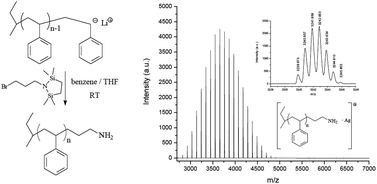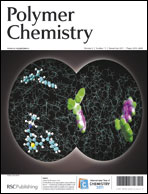Chain-end functionalization of living poly(styryl)lithium using 1-(3-bromopropyl)-2,2,5,5-tetramethyl-1-aza-2,5-disilacyclo-pentane (BTDP) to generate primary amine end-functionalized polystyrene was investigated using high vacuum anionic polymerization techniques. 13C NMR spectroscopy and Matrix Assisted Laser Desorption Ionization Time-of-Flight Mass Spectrometry (MALDI-TOF MS) were used to evaluate polymer end-groups and demonstrated that quantitative amine functionalized polymer was attained under appropriate reaction conditions. In general, the polymerization of styrene was conducted in benzene and the end-capping reaction was performed by adding tetrahydrofuran (THF) to the reaction prior to the addition of BTDP in THF at room temperature. Results indicated that approximately 20% THF by volume is required to obtain 100% end-capping free from side reactions. When too little or no THF was present, side reactions such as lithium halogen exchange followed by Wurtz coupling resulted in unfunctionalized head-to-head dimer as well as other byproducts. Modeling and simulation of the solvent effects using hybrid methods (the so-called QM/MM method) suggest that THF effectively dissociated the anionic chain-end aggregation, thereby resulting in the desired primary amine functionalized polymer. Molecular dynamics (MD) simulations were conducted to develop an understanding of the physics of counterions involved in the end-functionalization process.

You have access to this article
 Please wait while we load your content...
Something went wrong. Try again?
Please wait while we load your content...
Something went wrong. Try again?


 Please wait while we load your content...
Please wait while we load your content...